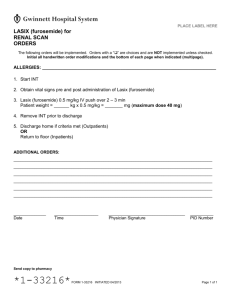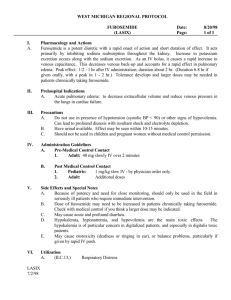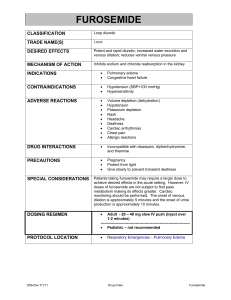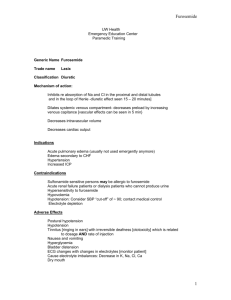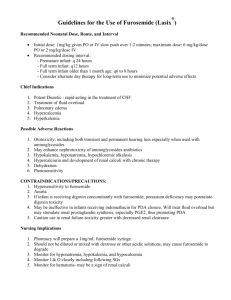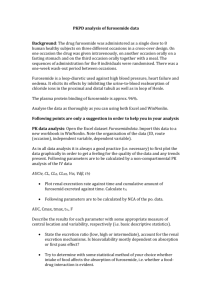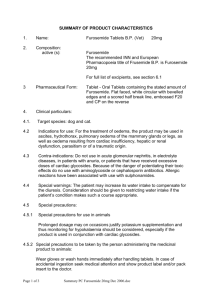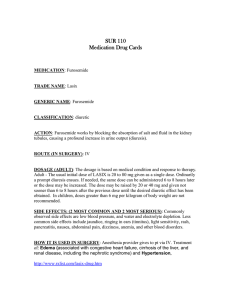Document 14258060
advertisement
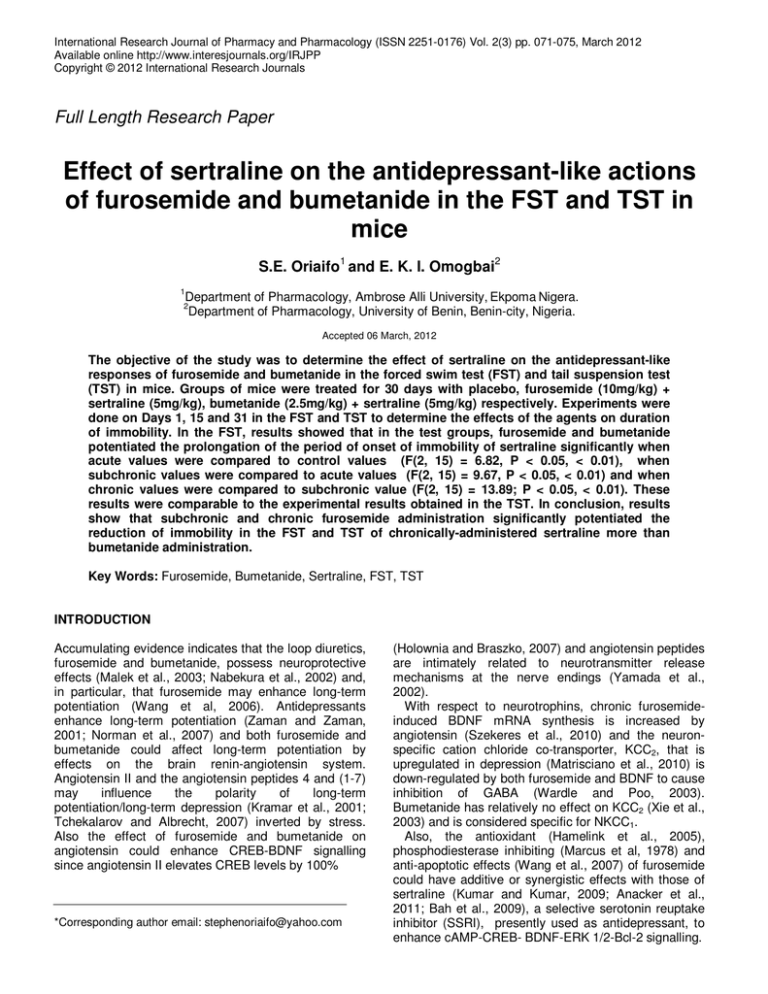
International Research Journal of Pharmacy and Pharmacology (ISSN 2251-0176) Vol. 2(3) pp. 071-075, March 2012 Available online http://www.interesjournals.org/IRJPP Copyright © 2012 International Research Journals Full Length Research Paper Effect of sertraline on the antidepressant-like actions of furosemide and bumetanide in the FST and TST in mice S.E. Oriaifo1 and E. K. I. Omogbai2 1 Department of Pharmacology, Ambrose Alli University, Ekpoma Nigera. Department of Pharmacology, University of Benin, Benin-city, Nigeria. 2 Accepted 06 March, 2012 The objective of the study was to determine the effect of sertraline on the antidepressant-like responses of furosemide and bumetanide in the forced swim test (FST) and tail suspension test (TST) in mice. Groups of mice were treated for 30 days with placebo, furosemide (10mg/kg) + sertraline (5mg/kg), bumetanide (2.5mg/kg) + sertraline (5mg/kg) respectively. Experiments were done on Days 1, 15 and 31 in the FST and TST to determine the effects of the agents on duration of immobility. In the FST, results showed that in the test groups, furosemide and bumetanide potentiated the prolongation of the period of onset of immobility of sertraline significantly when acute values were compared to control values (F(2, 15) = 6.82, P < 0.05, < 0.01), when subchronic values were compared to acute values (F(2, 15) = 9.67, P < 0.05, < 0.01) and when chronic values were compared to subchronic value (F(2, 15) = 13.89; P < 0.05, < 0.01). These results were comparable to the experimental results obtained in the TST. In conclusion, results show that subchronic and chronic furosemide administration significantly potentiated the reduction of immobility in the FST and TST of chronically-administered sertraline more than bumetanide administration. Key Words: Furosemide, Bumetanide, Sertraline, FST, TST INTRODUCTION Accumulating evidence indicates that the loop diuretics, furosemide and bumetanide, possess neuroprotective effects (Malek et al., 2003; Nabekura et al., 2002) and, in particular, that furosemide may enhance long-term potentiation (Wang et al, 2006). Antidepressants enhance long-term potentiation (Zaman and Zaman, 2001; Norman et al., 2007) and both furosemide and bumetanide could affect long-term potentiation by effects on the brain renin-angiotensin system. Angiotensin II and the angiotensin peptides 4 and (1-7) may influence the polarity of long-term potentiation/long-term depression (Kramar et al., 2001; Tchekalarov and Albrecht, 2007) inverted by stress. Also the effect of furosemide and bumetanide on angiotensin could enhance CREB-BDNF signalling since angiotensin II elevates CREB levels by 100% *Corresponding author email: stephenoriaifo@yahoo.com (Holownia and Braszko, 2007) and angiotensin peptides are intimately related to neurotransmitter release mechanisms at the nerve endings (Yamada et al., 2002). With respect to neurotrophins, chronic furosemideinduced BDNF mRNA synthesis is increased by angiotensin (Szekeres et al., 2010) and the neuronspecific cation chloride co-transporter, KCC2, that is upregulated in depression (Matrisciano et al., 2010) is down-regulated by both furosemide and BDNF to cause inhibition of GABA (Wardle and Poo, 2003). Bumetanide has relatively no effect on KCC2 (Xie et al., 2003) and is considered specific for NKCC1. Also, the antioxidant (Hamelink et al., 2005), phosphodiesterase inhibiting (Marcus et al, 1978) and anti-apoptotic effects (Wang et al., 2007) of furosemide could have additive or synergistic effects with those of sertraline (Kumar and Kumar, 2009; Anacker et al., 2011; Bah et al., 2009), a selective serotonin reuptake inhibitor (SSRI), presently used as antidepressant, to enhance cAMP-CREB- BDNF-ERK 1/2-Bcl-2 signalling. Oriaifo and Omogbai 072 Bumetanide may also possess antioxidant effects (Geng et al., 2009) since it down-regulates, like furosemide, the inwardly-directing sodium-potassiumchloride co-transporter (NKCC1), thereby attenuating the effects of the oxidative stress-response kinase (OSRK1) in activating NKCC1. Evidence has been shown that furosemide administration down-regulates the dopamine transporter (Lucas et al., 2003) and studies suggest a functional cooperation exists amongst serotonergic, noradrenergic and dopaminergic systems in the brain (Vizi et al., 2003). The aim of the study was to evaluate the effects of sertraline on the antidepressant-like responses of furosemide and bumetanide in the FST and TST in mice. recorded. In this experiment, the mice were pre-treated i.p. according to the following protocol: Group 1 received 0.25 ml of placebo daily for 30 days Group 2 received 5mg/kg of sertraline + 2.5mg/kg of bumetanide daily for 30 days Group 3 received 5mg/kg of sertraline + 10mg/kg of furosemide daily for 30 days Tests were done on Days 1 (acute), 15 (subchronic) and 31 (chronic) when the dose of furosemide was increased to 100mg/kg and that of bumetanide to 75mg/kg but the dose of sertraline remained unchanged. Drug studies with the tail suspension test MATERIALS AND METHODS Male albino mice (25-35g) were used. Groups of mice were housed in the University’s departmental laboratory in separate plastic cages for four weeks prior to testing. Animals were housed at room temperature of 25º-27ºC in a 12-hour light/dark cycle. They were given pretreatments of intraperitaneal injections, allowed food and water ad libitum, and on the day of the test transported to the sound-proof testing area in their own cages. All drugs were supplied by Sigma-Aldrich through Rovet Chemicals, Benin –City, Nigeria. All the drugs were dissolved in 10% Tween 80 in distilled water because of furosemide’s solubility. The mice were injected intraperitoneally (i.p.). The doses of drugs were chosen from previous studie (Eraly et al., 2006; Luszczki et al., 2003; Cryan et al., 2004; Kosuda et al., 1997; Hesdorfffer et al., 2001; Aburawi et al., 2007). Drug studies with the forced swimming test Male albino mice (25-35g), after pre-treatments and acclimatisation in the departmental laboratory were transported to the sound-proof testing area in their own labelled cages. They were allowed to adapt for one hour before the intraperitoneal injections after which there was a wait–period of 60 minutes before the tests of immobility. Mice were forced to swim for four minutes in a vertical glass cylinder of height 27cm, diameter 16.5cm and containing fresh tap water to a depth of 15cm at 27ºC. A behavioural model of immobility first postulated by Porsolt, (1977) and named the behavioural despair model was used. In this model, mice are forced to swim in a restricted space from which escape is not possible. Following an initial period of vigorous activity, the mice become helpless and adopt a characteristic immobile posture with no further attempt to engage in escaperelated behaviour; and this reflects a state of despair or lowered mood. The period of on-set of immobility is timed by an observer unaware of the drug given and Male albino mice weighing 25-35g were used. They were housed in the departmental laboratory in labelled metal cages for 30 days prior to testing, in a 12-hour light/dark cycle with food and water freely available. The mice were transported from the housing room to the sound-proof testing area in their own cages and allowed to adapt to the new environment for one hour before testing. The groups of mice were treated with the test compounds by intraperitoneal (i.p.) injection one hour prior to the test of immobility. In the TST first formulated by Steru et al (1985), the mice are suspended on the edge of a shelf 58cm above a table-top by adhesive tape placed approximately 1cm from the tip of the tail. The duration of immobility is recorded for a period of 5 minutes by an observer unaware of the test compound In this experiment, the mice were pre-treated i.p. according to the protocol adopted for the FST. Tests were done on Days 1 (acute), 15 (subchronic) and 31 (chronic) when the dose of furosemide was increased to 100mg/kg and that of bumetanide to 75mg/kg but the dose of sertraline remained unchanged. Statistical analysis One-way ANOVA was applied followed by DMR as post-hoc test. Mann-Whiney non-parametric test was used when comparing the means of only two samples. The difference was considered to be significant at P < 0.05, < 0.01). RESULTS In the FST (Figure 1), while the onset of immobility in the control group was 43.75 ± 1.04 seconds, the combination of furosemide (100mg/kg) + sertraline (5mg/kg) prolonged the onset to 125.90 ± 1.33 seconds at Day 1 (acute), to 150.00 ± 2.00 seconds at Day 15 (subchronic) and to 177.90 ± 2.89 seconds at Day 31 (chronic). The response at Day 31 was a synergistic Onset of Immobility in Seconds + SEM 073 Int. Res. J. Pharm. Pharmacol. 20 0 20 0 20 0 * * C * 15 0 F+ * 10 0 15 F+ 0 * S * F+ S S 10 0 * 10 0 ACUTE 50 SUBCHRONI 50 C C 15 0 * 50 * CHRONIC C Figure 1. Effect of sertraline on the acute, subchronic and chronic antidepressantlike actions of furosemide and bumetanide in the fst in mice. The vertical bars represent the values in seconds + S.E.M. The furosemide + sertraline and bumetamide + sertraline combination at the doses shown significantly prolonged the period of onset of immobility of mice when acute values are compared to control values ( F( 2, 15) = 6.82; ( P < 0.05, < 0. 01), when subchronic values are compared to acute values (F( 2, 15) = 9. 67; ( P< 0.01) and when chronic values are compared to subchronic values (F9 2, 15) = 13.89; (P< 0.05, < 0.01). At the three instances, the post-hoc DMR test showed the furosemide + sertraline combination to be most significant. 300 300 300 250 250 250 Durationof Immobility inSeconds + SEM * * * 200 200 150 200 C 150 150 C C F+S * 100 * F+S F+S 100 * B+S B+S 100 * * B+S * 50 50 0 50 0 ACUTE 0 SUBCHRONIC CHRONIC Figure 2. Effect of sertraline on the acute, subchronic and chronic antidepressant-like actions of furosemide and bumetanide in the tst in mice. The vertical bars represent the values in seconds + S.E.M. The furosemide + sertraline and bumetamide + sertraline combinations at the doses shown significantly enhanced the reduction of immobility of mice when acute values are compared to control values (F2, 15) = 7.63; (P < 0.05, < 0.01), when subchronic values are compared to acute values (F(2, 15) =12.34; (P < 0.05 < 0.01,) and when chronic values are compared to subchronic values (F(2, 15) = 19.05; (P < 0.05, < O.01). At the three instances, the post-hoc DMR test showed the furosemide + sertraline combination to be more significant. response because it was more than the sum of the individual responses. The bumetanide (75mg/kg) + sertraline (5mg/kg) combination prolonged the period of onset of immobility to 86.65 ± 1.19 seconds at Day 1 (acute), 104.80 ± 0.80 seconds at Day 15 (subchronic) and to 116.30 ± 1.29 seconds at Day 31 (subchronic). Statistical analysis showed the combinations prolonged the period of onset of immobility significantly when acute values were compared to control values (F(2, 15) = 6.82; P < 0.05, < O.01), when subchronic values were Oriaifo and Omogbai 074 compared to acute values (F(2, 15) = 9.67; P < 0.05, < 0.01) and when chronic values were compared to subchronic values (F(2, 15) = 13.89, P < 0.05, < 0.01). At the three instances, post-hoc DMR test showed the furosemide + sertraline combination to be more significant. In the TST (Figure 2), while the duration of immobility in the control group was 211.72 ± 4.39 seconds, the combination of furosemide (100mg/kg) + sertraline (5mg/kg) reduced the duration of immobility to 79.39 ± 4.50 seconds at Day 1 (acute), to 77.80 ± 1.31 seconds at Day 15 (subchronic) and to 61.01 ± 0.88 seconds at Day 31 (chronic). The bumetanide (75mg/kg) + sertraline (5mg/kg) combination reduced the duration of immobility to 100.70 ± 3.36 seconds at Day 1 (acute), 86.42 ± 5.27 seconds at Day 15 (subchronic) and to 80.39 ± 0.90 seconds at Day 31 (subchronic). Statistical analysis showed the combinations prolonged the reduction of immobility significantly when acute values were compared to control values (F(2, 15) = 7.63; P < 0.05, < O.01), when subchronic values were compared to acute values (F(2, 15) = 12.34; P < 0.05, < 0.01) and when chronic values were compared to subchronic values (F(2, 15) = 19.05, P <0.05, < 0.01). At the three instances, post-hoc DMR test showed the furosemide + sertraline combination to be more significant. DISCUSSION Results show that subchronic and chronic furosemide + sertraline administrations significantly enhances the reduction of immobility (P < 0.05, < 0.01) in the FST and TST models of depression using mice over that of the acute administration, and over that of the bumetanide + sertraline combination. The furosemide + sertraline combination showed synergy after 30 days of treatment of mice. The diuretic and renin-releasing effects of furosemide seems to have no major relationship to its demonstrated anti-depressant-like activity for furosemide showed a more significant antidepressant-like efficacy compared to bumetanide even though bumetanide is a more potent diuretic (Ramsay et al., 1978) and shows a greater effect in inducing renin release (Scholz et al., 1993). Bumetanide’s effects in preventing apoptosis (Marklund et al., 2001) may enhance cell resilience and neuroplasticity but again, the Bax blocker, furosemide has more effects as it reduces the Bax/Bcl-2 ratio (Sanchez-Gomez et al., 2011). The more robust antioxidant status of furosemide and its free radicalscavenging effects (Lahet et al., 2003) means that furosemide is able to, more potently, attenuate excitotoxicity mediated by reative oxygen species caused by sustained Ca2+ increases due to glutamate, AMPA and kainite receptors (Sanchez-Gomez et al, 2011) and this attribute of furosemide may partially explain its synergy with sertraline in our experiments. Additionally, furosemide’s activation of the endogenous antidepressant enkephalin/mµ-opioid receptor system (Grondin et al., 2011), an attribute bumetanide has not been reported to share, may enhance its antidepressant-like actions. The phosphodiesterase- and adenosine-inhibiting actions of furosemide (Marcus et al., 1978; O’Connor et al., 1991) could enhance those of sertraline and increase cAMP-CREB-BDNF signaling. Furosemide inhibits adenosine with more efficacy than bumetanide (Polosa et al., 1993). By its effect as a KCC2 downregulator (Wang et al., 2006), an attribute it shares with BDNF (Wardle and Poo, 2000), furosemide may enhance CREB-BDNF signalling and induce neurogenesis (Roitman et al., 2002), an important factor in the induction of long-term potentiation. The synergistic effect furosemide + sertraline displayed from our experiments may find further explanation at a down-stream level involving BDNF release since furosemide upregulates BDNF production which can synergise with serotonergic agent (Deltheil et al., 2009) and secondly, the serotonergic system has been found (Kozisek et al., 2004) to mature earlier than the noradrenergic system. We have shown in a previous report that furosemide enhances noradrenergic signalling to mediate its effects. This action of furosemide could synergise with serotonergic signalling mediated by sertraline to cause the synergistic response observed in our experiments. In conclusion, results of the experiments provide evidence that chronic administration enhances the effect of furosemide + sertraline combination above that of bumetanide + sertraline combination in reducing immobility of mice in the FST and TST models of depression. REFERENCES Aburawi SM, Al-Tubuly RA, Alghzewi EA, Gorash ZM (2007). Effects of calcium channel blockers on antidepressant action of alprazolam and imipramine. Libyan Med. J. AOP: 070909 (published 17 October, 2007). Anacker C, Zunszain PA, Cattaneo A, Carvalho LA, Garabediau MJ, Thuret S, Price J, Pariante CM (2011). Antidepressants increase human hippocampal neurogenesis by activating the glucocorticoid receptor. Mol. Psychiatry. doi: 10.1038/mp.2011.26: 1-13. Bah TM, Kaloustian S, Boucher M, Dufort AM, Le Marec N, Godbout R, Rousseau G (2009). Behavioural signs of depression and apoptosis in the limbic system following myocardial infarction: effects of sertraline. J. Psychopharmacol. 23(4): 451-459 Cryan J, O’Leary O, Jin S, Friedland J (2004). Norepinephrinedeficient mice lack responses to antidepressant drugs, including selective serotonin reuptake inhibitors. PNAS. 101(21): 8186-8191 Deltheil T, Tanaka K, Reperant C, Hen R, David DT, Gardier AM (2009). Synergistic neurochemical and behavioural effects of acute intrahippocampal injection of brain-derived neurotrophic factor and antidepressants in adult mice. Int. Journ. Neuropsychopharmacology. CINP doi: 10.1017/S1461145709000017. Eraly SA ,Valon V, Vaughan D (2006). Decreased renal organic anion secretion and plasma accumulation of endogenous organic anions in OAT-knockout mice. Biological Chemistry. 281: 5072-5082. Geng Y, Hoke A, Delpire E (2009). The Ste20 kinases Ste20-related 075 Int. Res. J. Pharm. Pharmacol. Proline-Alanine-Rich Kinase and Oxidative-Stress Response Kinase 1 regulate NKCC1 function in sensory neurons. The J. Biol. Chem. 284: 14020-14028; doi: 10.1074/jbc.m900142200. + Grondin M-E, Gobeil-Simard A, Drolet G, Mouginot D (2011). Na appetite induced by depleting extracellular fluid volume activates the enkephalin/mµ-opioid receptor system in rat forebrain. J. Neurosci. In Press, doi: 10.1016/j.neurosci. 2011.66.054. Hamelink C, Hampson A, Wink DA, Eiden LE, Eskay RL (2005). Comparison of cannabidiol, antioxidants and diuretics in reversing binge ethanol-induced neurotoxicity. JPET. 314(2): 780-788. Hesdorffer D, Stables JP, Hauser H, Annegers J, Cascino G, Sergievsky GH (2001). Are certain diuretics also anticonvulsants Annals of Neurology. 50(4): 458-462. Holownia A, Braszko JJ (2007). The effect of angiotensin 11 and IV on ERK 1/2 and CREB signaling in cultured rat astroglial cells. Naunyn-Schmiedeberg’s Archives of Pharmacology. 376: 157-163. Kosuda S, Fisher S, Wahl R (1997). Animal studies on the reduction and/or dilution of 2-deoxy-2 (18F) fluoro-D-glucose (FDG) activity in the urinary system. Annals of Nuclear Medicine. 11(3): 213-218. Kozisek ME, Middlemas D, Bylund DB (2008). The differential regulation of BDNF and TrkB levels in juvenile rats after four days of escitalopram and desipramine treatment Neuropharmacology. 54(2): 251-257. Kramar E, Armstrong DL, Ikeda S, Wagner MJ, Harding JW, Wright JM (2001). The effects of angiotensin IV analogs on long-term potentiation within the CAI region of the hippocampus in vitro. Brain Research. 897(1-2): 114-21. Kumar P, Kumar A (2009). Protective role of sertraline against 3nitropropionic acid-induced cognitive dysfunction and redox ratio in striatum, cortex and hippocampus of rat brain. Indian Journal of Experimental Biology. 47(9): 715-22. Lahet JJ, Lenfant F, Courderot-Masuyer C, Ecarnot-Laubriet E (2003). In vivo and in vitro antioxidant properties of furosemide. Life Sciences. 73(8): 1075-1082 Lucas LR, Grillo CA, McEwen BS (2003). Involvement of mesolimbic structures in short-term sodium depletion: In situ hybridization and ligand binding analysis Neuroendocrinology. 77: 406-415. Luszczki J, Sawicka K, Kozinska J, Borowiczka K, Czuczwa S (2003). Furosemide potentiates the anticonvulsant action of valproate in the mouse maximal electroshock seizure model. Epilepsia Research . 76(1): 66-72. Malek SA, Coderre E, Stys PK (2003). Aberrant chloride transport contributes to anoxia/ischemic white matter injury. Journal of Neuroscience. 23(9): 3825-3836 Marcus R, Orner F, Arvessen G, Lundquist C (1978). Thiazide diuretics do not potentiate cAMP response to parathyroid hormone. Metabolism. 27(6): 701-10 MarklundL, Behnam-Motlagh P, Henriksson R, Grankvist K (2001). Bumetanide annihilation of amphotericin B-induced apoptosis and + cytotoxicity is due to its effect on cellular K flux. Journ. Antimicrob Chemotherapy. 48: 781-6 Matrisciano F, Nasca C, Molinaro G, Riozzi B, Scaccianoce S, Raggi + MA (2010). Enhanced expression of the neuronal K /Cl cotransporter, KCC2, in spontaneously depressed Flinders Sensitive Line rats . Brain Research. 1325: 112-120 Nabekura J, Ueno T, Okabe A (2002). Reduction of KCC2 expression and GABAA receptor-mediated excitation after in vivo axonal injury. Journal of Neuroscience. 22: 4412-4417 Normann C, Schmitz D, Furmaler A, Doing C, Bach M (2007). Longterm plasticity of visually evoked potentials in humans is altered in major depression. Biol Psychiatry. 62(5): 373-80 O’Connor BJ, Chung KF, Chen-Worsdell YM, Fuller RW, Barnes PJ (1991). Effect of inhaled furosemide and bumetanide on adenosine 5’monophosphate and sodium metabisulfite-induced bronchoconstriction in asthmatic subjects. The American Review of Respiratory Disease. 143(6): 1329-33 Polosa R, Rajakulasingam K, Prosperini G, Church MK, Holigate ST (1993). Relative potencies and time-course of changes in adenosine 5’monophosphate airway responsiveness with inhaled furosemide and bumetanide in asthma. Journal of Allergy and Clinical Immunology. 92(2): 288-297 Porsolt RD, Bertin A, Jalfre M (1977b). Behaviour despair in mice: a primary screening test for antidepressants. Arch. Int. Pharmacodyn. Ther. 229: 327-336 Ramsay LE, McInnes GT, Hrttiarachchi J, Scott P (1978). Bumetanide and furosemide: a comparison of dose-response curves in healthy men. Br. J. Clin. Pharmacol. 5(3): 243-247 Roitman MF, Na ES, Anderson G, Jones TA, Bernstein I (2002). Induction of a salt appetite alters dendritic morphology in nucleus accumbens and sensitizes rats to amphetamine. The Journal of Neuroscience. 22 RC225(1-5) Sanchez-Gomez MV, Alberdi E, Perez-Navarro E, Alberch J, Matute C (2011). Bax and calpain mediate excitotoxic oligodendrocyte death induced by activation of both AMPA and Kainate receptors. Journal of Neuroscience. 31(8): 2996-3006 Scholz H, Urs Vogel and Armin Kurtz (1993). Interrelation between baroreceptor and macula densa mechanisms in the control of renin secretion. Journal of Physiology. 469: 511-524 Steru L, Chermat R, Thierry B, Simon P (1985). The tail suspension test: A new method for screening antidepressants in mice. Psychopharmacology (Berl). 85(3): 367-70 Szekeres M, Nadasy GL, Turu G, Supeki K, Svidonya L, Chaplin T, Clark A, Hunyady L. (2010). Angiotensin 11-induced expression of BDNF in human and rat adrenocortical cells. Endocrinology. 151(4):1695-1703 Tchekalorova J, Albrecht D (2007) Angiotensin 11 suppresses longterm depression in the lateral amygdala of mice via L-type calcium channels. Neuroscience Lett. 415(1): 66-72 rd Vizi ES, Zsilla G, Caron MG, Kiss JP (2003). S9-2 3 Federation of European Physiological Societies (FEPS), 2003, Nice, France; OnLine Wang Q-F, Chiang C-W, Wu C-C (2007). Gypenosides induce apoptosis in human hepatoma Huh-7 cells through a calcium/reactive oxygen species-dependent mitochondrial pathway. Planta Medica. 73(6): 535-544 Wang W, Gong N, Xu T-L (2006). Down-regulation of KCC2 following LTP contributes to EPSP-spike potentiation in rat hippocampus. Biochemical and Biophysical Research Communications. 343(4): 1209-1215 Wardle RA, Poo MM (2003). Brain-derived neurotrophic factor modulation of GABAergic synapses by post-synaptic regulation of chloride transport. The Journal of Neuroscience. 23(25): 87228732 Xie Z, Currie KPM, Cahill AL, Fox AP (2003). Role of Clcotransporters in the excitation produced by GABAA receptors in juvenile bovine adrenal chromaffin cells. Journal of Neurophysiology. 90: 3828-3837 Yamada M, Higuchi T (2002). Functional genomics and depression research. Beyond the monoamine hypothesis. European Neuropsychopharmacology. 12: 235-244 Zaman SH, Zaman R (2001). Correspondence: Long-term potentiation and changes seen in depression. Brit. Journ. Psychiatry. 179: 559-560
